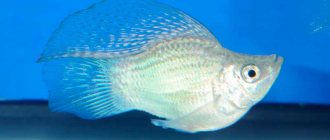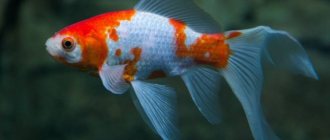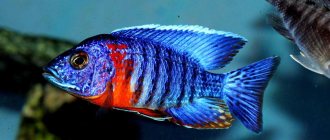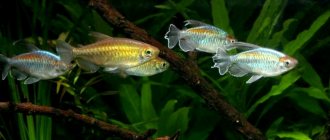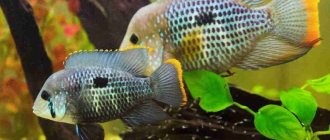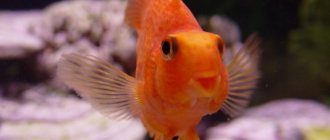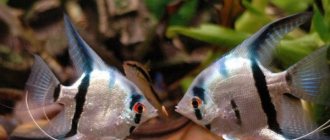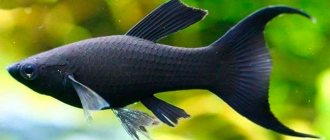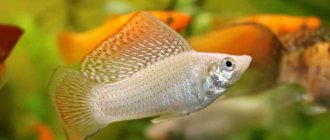Mollies (lat. Poecilia
) is a large, agile and easy-to-keep fish, the Russian name comes from the previously used
Mollienesia
. She gets along well with other peaceful inhabitants of the aquarium. Pet stores offer a wide selection of fish that differ from each other in shape and color. The size of adult individuals depends on the species and ranges from 7 to 12 cm.
The habitat is very extensive. Fish have adapted to live in fresh water bodies, brackish bays and even sea coasts. The molly sphenops lives in the waters of Mexico and Colombia. Velifera inhabits the rivers and lakes of the Yucatan Peninsula in Mexico. And the mollies latipin lives in brackish waters of Florida, Texas, Virginia and the Carolinas.
Historical information
In 1846, zoologist Adil Valansienov described the molly sphenops. And only 50 years later, Charles Organ described the Velifera molly and the free molly. Molliesia latipin came to Europe in 1913.
Selected morphs began to appear in 1920. At the same time, breeders crossed three species of fish. By breeding the sphenops molly in 1925 in Florida, Jack Bitter, a black and speckled form was obtained. Further selection was continued by Bill Sterneck. He managed to breed a black velvet form of molly. She came to us 10 years later. A little later, Sternek developed an albino form of this fish. And even later, fish with a shortened body and a convex abdomen appeared.
Description
Valued for its unusual color, ability to reproduce in a community aquarium, and livability.
Appearance
The body is elliptical, elongated. Laterally compressed. The mouth is large, oriented upward. The color of the body and fins is velvety black. Aquarists consider the presence of light spots to be a defect.
The latest achievement of breeders is the tail fin of the black molly in the shape of a rotated letter “Ω”. The ends are pointed. There are varieties with the dorsal fin extended towards the tail.
Males grow up to 50–60 mm, females – up to 60–80 mm.
Lifestyle
They are mobile in all areas of the aquarium and playful. Males are especially active. In an overcrowded tank and when there is a shortage of females, they are aggressive towards their relatives and defend the territory. Keep at a rate of 2 females to 1 male.
The situation is similar with a lack of food. Only females show aggression.
In nature, they are schooling fish. In captivity, gregariousness is less pronounced.
Lifespan
The black molly fish lives 3–3.5 years.
Varieties of mollies
Nowadays there are four natural species of fish:
1. Small-finned molly, or sphenops molly (Poecilia sphenops)
2. Free mollies (Poecilia salvatoris)
3. Velifera molly (Poecilia velifera)
4. Latipin molly (Poecilia latipinna)
Other varieties found commercially are selection morphs. Now let's look at each type in more detail.
Interesting facts about mollies
- The appearance of mollies fry always occurs at dawn.
- Mollies sometimes experience degeneration, that is, a change in sex. This can happen both at an early age and in adulthood.
- The number of babies is determined by the size of the female. As a rule, a large female produces more offspring. The largest number of fry in one birth is 280 pieces.
- Mollies with a black body color are not a separate species. Instances of this color can appear within any species of these fish.
- There have been cases of white fry from black spawners. This is explained by heredity and connections with previous generations. The white coloration of the fry is not always preserved - sometimes during the 1st month of life, black spots appear on the body of the fish, which become more and more numerous over time.
Mollies sphenops (Poecilia sphenops)
The body of the fish is dense, elongated and slightly compressed from the sides. The caudal fin is round in shape. The remaining fins are small. It takes food from the surface of the water and can scrape off algae. The size of adult individuals is 6-10 cm. Males are smaller than females. Their anal fin is transformed into a gonopodium.
In home aquariums, black specimens are most often found, but there are also artificially obtained colors: speckled, white and yellow. The tail of the fish is lyre-shaped.
Matte individuals with black velvet scales look unusually beautiful. The eyes of this species are almost invisible.
Reproduction and lifespan
It is not difficult to distinguish between a female and a male. The female individual is larger and less bright, there is a sense of roundness and some corpulence in her. The male molly is active, brightly decorated, and constantly shows off his outfit. Under normal living conditions, mollies can produce offspring every month.
Their mating activities are not associated with any season. A slight increase in temperature and an increase in the protein component in the diet can push the fish to begin reproduction. In a warm aquarium, the female carries the fry for just over 20 days. If the water temperature is below 22 °C, the embryo development process can take up to 40 days.
Experienced aquarists have a spawning aquarium ready by the time the offspring appears. The female, who shows all signs of readiness for childbirth, is placed in this individual dwelling. The spawning tank contains the same water as the main aquarium. Small-leaved plants are usually placed in it, among which newborn fish can hide.
Female mollies give birth to 10 to 100 young. If you return the parent to the community aquarium in time, then almost all the mollies fry will survive. To feed them, so-called live dust is released into the aquarium. At the age of one to two weeks, the fish begin to eat ground dry food.
Most mollies have a peculiarity: for the next birth of offspring, females do not need to meet a male. After a month, and sometimes earlier, the female can spawn another batch of fry without resorting to communication with the male. The ease of the reproductive process is probably one of the reasons for the popularity of mollies.
The need to survive makes the age of entry into adulthood very small for fish. To prevent uncontrolled reproduction, young males and females are seated in different containers. Since the differences between the sexes are quite significant, this can be done as early as two to three weeks of age.
Most viviparous fish, including mollies, have a peculiarity. Molly fry are born fully formed, capable of independent life. But they still go through the egg stage. The female molly leaves eggs in her womb. The embryos do not have a direct connection with the mother’s body, as in placental animals, they feed on the substances found in the eggs.
The process of exiting the eggs also takes place in the female’s body, after which a new fish is born. Therefore, it is more correct to call mollies not viviparous, but ovoviviparous. This method of birth preserves the lives of most of the offspring. In addition, it provides a simple change of generations in the aquarium, which is eagerly observed by amateur aquarists.
Mollies live 3-5 years. The method of reproduction makes the survival rate of the species very high. In addition, natural diversity and the speed of obtaining offspring are good conditions for carrying out breeding work. Judging by the number of artificially bred forms, the breeders are doing well.
The idea of directed selection is suggested by simple observation of fish. Three to four months after the guppies are introduced into the aquarium, males with unusually colored caudal fins may appear. This can happen even with uncontrolled fish reproduction.
For a correct, scientific approach to breeding work, the aquarist purchases or makes several aquariums. In larger ones - feeding ones - the younger generation of fish will be kept, males separated from females. Three pairs of breeders will live in personal containers.
Producers are periodically replaced with selected fish from their own offspring. To eliminate the negative impact of inbreeding, arrange the movement of males and females in such a way that fish that came from the same parents do not meet. A selection conveyor is launched, in which the best are constantly selected, but the closest relatives are not crossed.
The availability and effectiveness of breeding work with fish has turned this process into a hobby for many aquarists. In Russia, almost every year there is a competition for newly bred guppies. The same festivals are held in many European and Asian countries. The best fish are sold at auction. The only “but”: the newly obtained forms may not pass on their qualities to the offspring.
Velifera molly, or sailing molly (Poecilia velifera)
This is the largest species of mollies. In an aquarium they grow up to 13 cm, and in nature up to 16 cm. The dorsal fin resembles a sail, hence the name of the fish. The fin size can reach 4-5 cm. The tail is round in shape, turquoise along the contour and orange in the middle. The dorsal fin is edged with orange or black. The body color in nature is silver with horizontal dotted lines. There are individuals with an orange front part of the body. Females are grey-green with dotted lines. There are a variety of color mofs on sale - Dalmatian, Yucatan.
Description of Mollies
Mollies have a dense, short body with a strong fin and a light belly. Females are much larger than males: the body size of males is ten centimeters, females - sixteen centimeters. Yellow-gray color is the main body tone of individuals, with spots of green, blue, black and yellow scattered throughout it. The sex of individuals is determined by the shape of the fin - in females it is rounded, in males it is rolled into a tube, forming a genopodia, which is their copulatory organ. The lifespan of Mollies is five years.
It is better to keep mollies in groups or pairs
This fish lives mainly in the upper and middle layers of water and loves water space and light.
The daylight hours of mollies should be at least 12-13 hours. It is useful for fish if the lighting is natural for at least a couple of hours a day, but if this is not possible, then you can do without it.
Of course, it also needs natural shelters: thickets of plants, snags, decorative ornaments that can serve as a refuge.
Mollies feed on all types of dry and live food. The only condition that helps keep these fish active and healthy is that they definitely need plant fiber.
Therefore, along with others, use vegetarian food, plant plants with soft leaves in the aquarium that the fish can eat. You can also feed them small portions of chopped boiled vegetables.
Another important point in keeping mollies: in their homeland they live where river water mixes with sea water, and therefore they love hard water. If your indoor pond contains only mollies and platies, you can even add a little salt to the water on purpose. If other fish live with them, then, of course, you shouldn’t do this. But in case of illness or quarantine, the fish can be placed in an aquarium with salted water - this way it will return to normal faster.
Breeding morphs
The golden molly is covered with yellow-orange scales with a slight white-blue tint. Eyes may be red.
Silver mollies or snowflakes are white with a silver tint. They look very nice with black individuals.
Balloon mollies differ from other species by their swollen abdomen and shortened body. Color can be black, orange, red and white. In individuals of this species, the internal organs are reduced, the spine is curved. They live only 1.5-2 years.
The lyretail molly is popular. Her tail resembles a crescent moon. The length of the tail of fish may vary.
From left to right: golden, silver, balloon and lyrebird
Mollies diseases
Unfortunately, gentle mollies are susceptible to a number of different diseases. All of them are the result of incorrect content. You can distinguish a sick fish by its unusual behavior: lethargic or, conversely, restless.
Gas embolism in mollies
Develops when there is an excess of oxygen in water. Most often this happens if you pour unsettled water straight from the tap into the aquarium. The disease is manifested by restlessness and darkening of the gills. Care and treatment in this case consists of changing the water.
Melanosis in mollies
The body becomes covered with spots of non-standard colors, which subsequently turn into tumors. This problem cannot be cured. Prevention lies in creating the right conditions of detention.
Colds in Mollies
If the fish become lethargic and apathetic, swim near the surface, and lose their appetite, it means they have a cold. The disease occurs if the water in the aquarium is too cold for mollies. Care and treatment in this case consists of creating the optimal temperature of the habitat. Life expectancy depends on the type of mollies. The average lifespan is from 4 to 8 years. Females live slightly longer than males. Balloon mollies can live no more than 2–3 years.
Mollies are an aquarium fish, easy to keep and breed, which will surely delight a caring owner with its beauty.
find out “Contact information” →
Mollies content
The fish are kept in an aquarium in schools of 6 or more individuals. In this case, there should be 2-3 females per male. The minimum volume of an aquarium is from 60 liters, and for a velifer from 100 liters. Mollies are active, so that they do not jump out of the aquarium, it must have a lid or be covered with cover glasses. Lighting must be bright, at least 10 hours a day.
Water parameters should be as follows: water temperature 25-27 degrees, acidity pH 7-8, hardness dH 7.0-20. Low water temperatures are poorly tolerated. In good conditions they live for about 4 years.
Choose dark soil for the aquarium. Driftwood, stones and many living plants are suitable as decoration. They prefer to swim in the middle and upper layers of water.
They can live in brackish water. You can add special sea salt to an aquarium in which only mollies live. The salt concentration should not exceed 2-3 g per liter of water. You should not add salt to a community aquarium.
The aquarium must have a filter installed and, if necessary, an aerator. When there is a lack of oxygen, fish rise to the surface of the water, and when there is a large amount of organic matter, they slow down and fold their fins. Siphon the soil weekly and replace 25-30% of the water with fresh water.
Maintenance and care
As mentioned earlier, due to their simplicity and unpretentiousness, mollies are suitable for keeping by beginning aquarists. They are able to adapt to a wide range of water parameters. But it is still recommended to maintain the most optimal conditions in the aquarium. The water temperature should be 23-28 degrees. Both neutral and slightly acidic water (pH= 7-8) is suitable. They feel great in hard water.
The ideal volume of an aquarium is 50-70 liters, depending on the number of fish living in it. The aquarium must be provided with good filtration and the water must be changed regularly. Fish are light-loving, so take care of bright lighting.
Mollies love to eat the leaves of some plants and scrape algae from the surface of decorations and soil. It will be useful to plant the aquarium with live plants. Sand or fine gravel is ideal as a soil.
Mollies compatibility
Platies, swordtails, rasboras, danios, ancistrus, corydoras catfishes, thoracatum catfishes, gourami, discus fish, bettas, small cichlids (Pelvicachromis pulchera, Sedzhik's cichlasoma, angelfish) get along well with nimble and peaceful mollies. Please note that angelfish and bettas prefer softer water than mollies.
Compatibility with other fish
Thanks to their boundless friendliness, mollies are ideal for keeping in a community aquarium and are compatible with all peaceful fish. But it is important to consider that they cannot be kept together with predatory or aggressive species. Fights may occur between male mollies.
Ideal neighbors: • Guppies • Swordtails • Danios • Corydoras
Mollies are very popular among aquarists. Various exhibitions and scientific conferences are held around the world, where you can see the best representatives of various breeds and color variations. Due to their unpretentiousness in maintenance and care, such fish are ideal for the very first aquarium in your life.
Breeding
Fish breeding does not require special conditions. The main thing is that there is a male and a female in the aquarium. The anal fin of the female is wide, and in the male it is modified into a gonopodium. In addition, females are larger than males. Males become sexually mature at the age of 8-12 months, and females at 5-6 months.
Females give birth to fully formed fry. That is, the eggs develop in the female’s abdomen for 30-40 days. Reproduction occurs both in a general aquarium and in a nursery. The female, ready for spawning, hides in the thickets of plants, her abdomen becomes large and a dark spot appears near the anus, which is faintly visible in black species.
Most often, the fry are born early in the morning. Their number depends on the age and size of the female and ranges from 50-300 fry. Once born, the babies lie at the bottom, and after a while they rise higher and begin to feed. If spawning took place in a spawning tank, then after the fry are born, the female is placed back in the general aquarium so that she does not eat the babies, or a separator net is placed. In a common aquarium, the one who manages to hide survives. The fry are fed 3-4 times a day. To do this, use dry food ground into dust or artemia nauplii. The water in the hatchery is changed daily. If this is not done, the juveniles may die.
How to distinguish a male from a female
The choice of a pair of sires plays an important role in obtaining healthy offspring. This is not difficult, since mollies have pronounced sexual dimorphism. As a rule, males are much smaller than females and have a mobile gonopodium - a modified anal fin that serves as a reproductive organ. Sexual maturity in fish occurs at 8-12 months for males, and at 5-6 months for females. When selecting, you need to pay attention to the strongest, most active and beautiful individuals.

